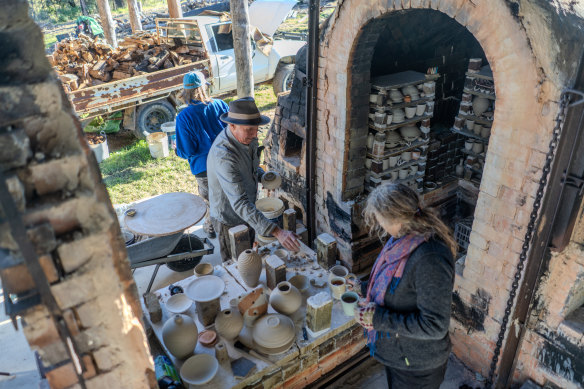
A month before the fires, the couple had taken measures to protect the house as they were in the midst of a 10-year drought, clearing their yard of dry debris and putting sprinklers on fence posts that could pump water straight out of the dam.
They’d also converted a Toyota Hilux truck with no windscreen that had crashed into an ad hoc firetruck with PVC tub and pump on the back. But it couldn’t save the studio.

‘Everyone wants to touch clay’: Bandicoot Pottery studio. Credit: Matt Nettheim
They made it home and kept defending the house for hours, putting out spot fires, with blazes now coming from two directions.
“The fire formed into a pyrocumulus cloud from fully grown gum trees burning 100 metres high. A big bolt of lightning went through it and then thunder went off. It was incredible,” Lafferty says.
After the fire eventually subsided, they realised how lucky they had been. “So many people were much worse off,” Powell says. “We had saved our house, even though we lost our studio, our sheds, our work, our tools and some of our vehicles. Three neighbours lost their homes and everything they owned.”
Nationally, the fires burned a fifth of Australia’s temperate forests, killed nearly 3 billion native animals and birds, and caused the deaths of 33 people, including firefighters and people defending their homes.
The fires did have a silver lining because they led to a creative upsurge in the community, Powell says. This included the Painted Pole Project, which rallied local artists together to paint 88 electricity poles in Cobargo. Meanwhile, the Spiral Gallery, an artists-run co-operative in Bega, held various community art exhibitions with proceeds going to the region’s recovery.
At Bandicoot Pottery, for the first time, they also started holding pottery and basket weaving classes for the community, with grants from Create NSW. This included a women’s recovery project so participants could make tableware for their homes, destroyed in the fires. Other classes were for homeschooled children, youth and school holiday programs.
“Visitors also come from Batemans Bay, Eden, Cooma and Canberra, even Wollongong, to attend classes,” Lafferty says. “It seems everyone wants to touch clay.”









 Add Category
Add Category